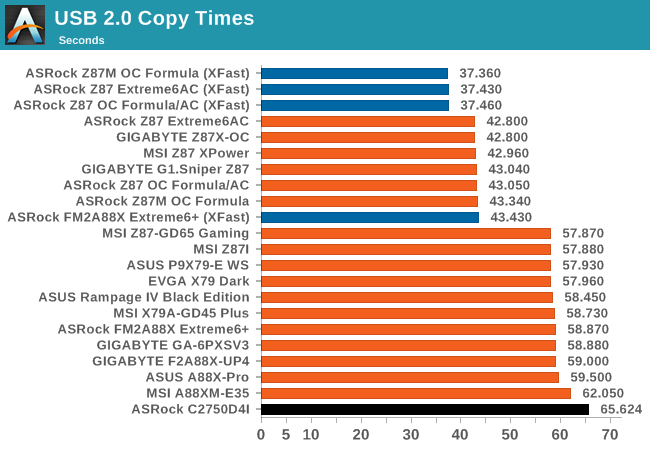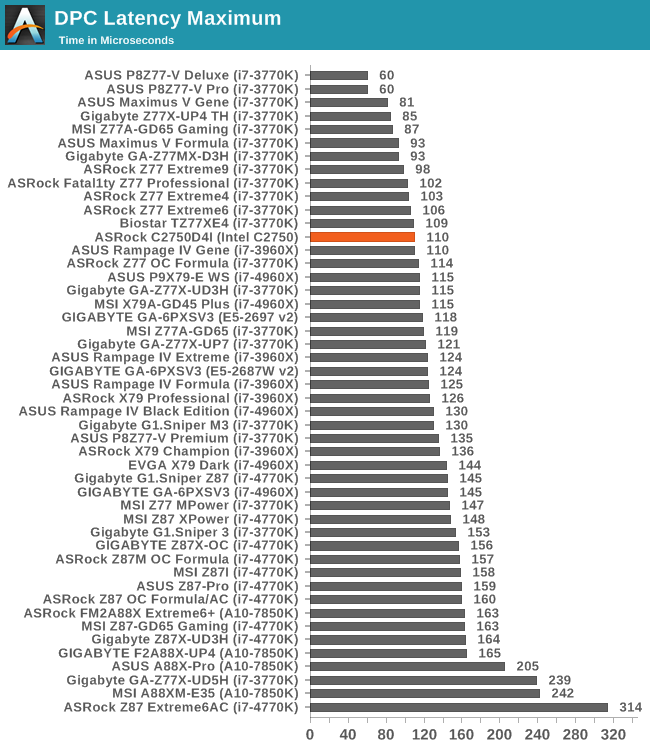ASRock Rack C2750D4I Review: A Storage Motherboard with Management
by Ian Cutress on April 29, 2014 9:00 AM EST- Posted in
- Motherboards
- Storage
- Atom
- ASRock
- Silvermont
- Enterprise
- server
- Avoton
System Benchmarks
USB Backup
For this benchmark, we run CrystalDiskMark to determine the ideal sequential read and write speeds for the USB port using our 240 GB OCZ Vertex3 SSD with a SATA 6 Gbps to USB 3.0 converter. Then we transfer a set size of files from the SSD to the USB drive using DiskBench, which monitors the time taken to transfer. The files transferred are a 1.52 GB set of 2867 files across 320 folders – 95% of these files are small typical website files, and the rest (90% of the size) are the videos used in the WinRAR test. In an update to pre-Z87 testing, we also run MaxCPU to load up one of the threads during the test which improves general performance up to 15% by causing all the internal pathways to run at full speed.

USB effectiveness is often limited by how quickly a system can turn on all the pathways for the required data, as well as the underlying chipset implementation. Avoton is not going to win any records today for USB speed, and the lack of a USB 3.0 port is an oversight.
DPC Latency
Deferred Procedure Call latency is a way in which Windows handles interrupt servicing. In order to wait for a processor to acknowledge the request, the system will queue all interrupt requests by priority. Critical interrupts will be handled as soon as possible, whereas lesser priority requests, such as audio, will be further down the line. So if the audio device requires data, it will have to wait until the request is processed before the buffer is filled. If the device drivers of higher priority components in a system are poorly implemented, this can cause delays in request scheduling and process time, resulting in an empty audio buffer – this leads to characteristic audible pauses, pops and clicks. Having a bigger buffer and correctly implemented system drivers obviously helps in this regard. The DPC latency checker measures how much time is processing DPCs from driver invocation – the lower the value will result in better audio transfer at smaller buffer sizes. Results are measured in microseconds and taken as the peak latency while cycling through a series of short HD videos - less than 500 microseconds usually gets the green light, but the lower the better.

While the system is not a digital audio workstation target, as our DPC test is quick and painless the results are included for completeness. The system actually does rather well, right in the middle of our Z77 testing.










85 Comments
View All Comments
S.D.Leary - Tuesday, April 29, 2014 - link
Actually, for the SMB/Home version I was thinking more along the lines of keeping all the management, but dropping the TPM.Dropping BOTH extra SATA switches. (No real need for these on a home Media Server, and honestly for many/most SMB, four 6TB drives would be more than enough)
Updating USB to 3.1 status
A digital video output.
Dropping the COM port
Thunderbolt 2 for external expansion (that way a SMB that was growing could add a storage chassis if needed)
And for Silverstone, a chassis with similar capabilities to the DS380, but with the following changes...
Drop 3.5" support. Ideally 4 Hot Swap 2.5" external bays, and one or two internal 2.5" bays.
An option for a Slim Optical drive.
Preferably a horizontal orientation to fit into an A/V setting.
Support for double wide normal graphics cards. This would probably necessitate a riser and horizontal orientation of the card.
Ian! A question for you. Do you have something that could test real time transcoding of Audio and Video? Both with and without a GPU?
SDLeary
Computer Bottleneck - Tuesday, April 29, 2014 - link
I like the idea of the consumer version as well.Make mine a C2550 and no additional SATA controllers. (SOC has six native SATA).
LastQuark - Monday, May 5, 2014 - link
You're looking at the wrong board. Check Bay Trail solutions. It will be perfect for your needs.swizeus - Tuesday, April 29, 2014 - link
Interesting as how Anandtech includes gaming benchmark for a storage centric motherboard, and with a decent card, it still be able to cope. What can you expect from a 25W CPU thoughLastQuark - Monday, May 5, 2014 - link
+1. It was a gross oversight of what this board is intended for.-=Hulk=- - Tuesday, April 29, 2014 - link
1. All recent Atoms (including Avaton's) support hardware AES acceleration:http://ark.intel.com/products/77987
2. 43W idle for the 5350??? What the hell??? I think your values are totally wrong....
50W for the C2758??? Look at that test with a similar Supermicro Mini-ITX motherboard:
http://www.servethehome.com/intel-avoton-rangeley-...
Ian Cutress - Tuesday, April 29, 2014 - link
Values aren't wrong, but the PSU is inefficient. Those values are also a full system build. I have to keep the same power supply across reviews for meaningful comparisons on the same efficiency curve, which I mention in the blurb above the power readings. I also mention that due to that fact, it's more a qualitative comparison than a quantitative.DanNeely - Tuesday, April 29, 2014 - link
I understand why you're using the same PSU for all your tests. But for really small/low power systems I'd suggest adding a second power test with a much smaller PSU, similar to how the old cast thermal tests for small enclosures were often done with both a big high power GPU and a small lower power one. The 1250W monster would allow for direct comparison with high power gaming systems; a second number from a ~250W PSU would provide a second number that would be more inline with typical use.watersb - Tuesday, April 29, 2014 - link
Wow! Thanks for writing about this one! I build small-office storage servers, and this might be exactly what we need!watersb - Tuesday, April 29, 2014 - link
"Users have been reporting that in Linux and FreeBSD, high intensity read/write workloads cause the controller to reset and elements to any software array are lost."Hmm. Not good. I see this with Sil3132 controllers, too. The PCIe x8 slot would let me install a modest controller like the old Intel/LSI SASUCI8, but that push the system price back into SuperMicro territory.